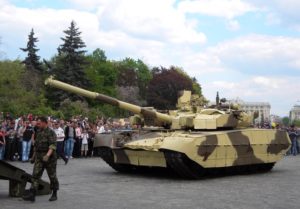
How the Oplot Was Almost the Yatagan
Some of the most vicious battles in Balkans in the 18th Century were between Ukrainian troops, under the command of the Russian Czar, and Ottoman troops, under the command of the Vizier. Fought on Russian dominated or contested territory, Ottoman troops would attack Ukrainian “Oplots,” which were thick, earthen bulwarks of defensive forts, providing protection to Ukrainian troops sheltering behind them. During the Battle of Kagul on 1 August 1770, infantrymen and artillerists commanded by Russian Field Marshal Rumyantsev defending behind Oplots prevented a superior Ottoman force of 100,000 Ottoman Tartar cavalry, and 150,000 Ottoman infantry from overwhelming a Russian force of 40,000 troops. The Oplots were decisive in the battle, allowing slow-moving infantry and cannon to take cover and win the day against the lighting-fast Ottoman cavalry, commanded by Grand Vizier Ivazzade Halil Pasha.
During the battle of Kagul, Ottoman troops in close combat used “Yatagan” swords, single bladed weapons, in a style which was relatively new at the time. They had no guard to protect the swordsman’s hand and were curved forward, instead of backward like scimitars. Most were made strictly for combat, with blades from 60cm to 80cm in length, but some were ceremonial, for parades and displays. During the battle, elite Janissaries carried shorter Yatagans, called Varsaks, to for ease during marching, while Tartar mounted cavalrymen carried longer Yatagans, to allow greater killing range from horseback. The building of defensive bulwarks was thousands of years old and last through the modern era, but Yatagans lasted a mere hundred years – they were approximately descended from cavalry sabers, briefly manufactured in Yatagan Turkey, and eventually replaced by bayonets, which were not as elaborate, but much more practical in battle.
So how is it possible that a Ukrainian Oplot almost turned into a Turkish Yatagan? In 2000, after the collapse of the Soviet Union divided one massively powerful arms industry into a handful of weak ones, Ukrainian arms manufacturers were in a quandary. The Ukrainian Malyshev (Little) Arms Factory which had produced high-tech Main Battle Tanks (MBTs) for the Soviet Army for decades found itself on the wrong side of the border for sales to the Russian Army. But worse, Malyshev was cut off from parts critical to making these 50 ton metal monstrosities. However, it was also free of Soviet restrictions on what could and be made, and to whom it could be sold. So the Ukrainian arms industry looked to attract new clients with new technologies, and created the M-84 Oplot, an advanced MBT with a powerful engine, advanced sensors, and an old Soviet 125mm main tank cannon.

The militaries of Pakistan and Thailand were buyers who wanted unmodified former Soviet equipment that could be assembled and sold mostly from parts on hand – they bought dozens of the M-84s. However, the Ukrainian government wanted new NATO markets. NATO had their own standards, different from the Soviet ones, but NATO paid top dollar, and NATO had a never ending hunger for advanced weapons. Selling MBTs was seen as a logical step, and the M-84 Oplot was a good, cheap weapons system. But the main tank cannon was a problem! NATO used 120mm rounds, and the M-84 used 125mm. The difference seems small, but is insurmountable – a 120mm round simply can’t be used in a 125mm cannon.
To fix the tank, Ukrainian engineers swapped out the cannon. They mounted a 120mm cannon on the Oplot, and renamed it after the Yatagan, in order to appeal to the Turkish market because the Turks were shopping for new MBTs. It was low maintenance, high-performance, and cheap. But the Turks were not ready for Ukrainian-made weapons yet. Instead, they started growing a nascent Turkish arms industry. They took their old German Leopard 1A1 MBTs and totally refurbished them. This was cheaper, faster, and created more effective MBTs than the Ukrainians were able to offer.
In the end, the MBT Oplot transformed into the Yatagan was no more able to conquer Turkey than the Ottoman Yatagan sword was able to conquer the Ukrainian Oplot.
- May 20, 2020
- Bosnia and Herzegovina , Serbia
